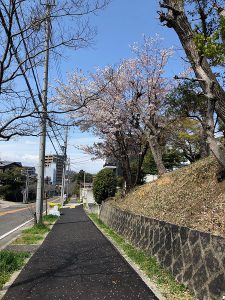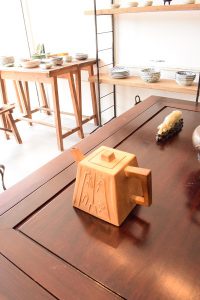早咲きの桜、早くも散っていました。(愛知県名古屋市千種区 古美術風光舎名古屋店 買取しております)
2021.03.22

皆さま、こんにちは。スタッフYです。
古美術風光舎名古屋店があります、千種区のご近所の写真です。よーくご覧になってください。よーく地面の辺りをご覧になってください。そうなんです。今朝、桜が早くも散っているところに遭遇。確か、先日開花宣言のお話をブログに掲載したと思いますが、これはいったい…。
早咲きの桜なんですね。びっくりしました。メジャーな桜といえば、〝ソメイヨシノ〟ですが、日本には現在600種類以上の桜があるといわれています。分類方法の違いもあって、正確には数え切れないレベルです。そんなたくさんの桜も、元をたどれば11種の「基本野生種」から生まれています。自然交配で生まれたものだけで100種以上あり、古くから園芸品種の育成も盛んです。
もとの基本野生種とは、ヤマザクラ(山桜)、オオヤマザクラ(大山桜)、カスミザクラ(霞桜)、オオシマザクラ(大島桜)、エドヒガン(江戸彼岸)、チョウジザクラ(丁字桜)、マメザクラ(豆桜)、タカネザクラ(高嶺桜)、ミヤマザクラ(深山桜)、クマノザクラ(熊野桜)、カンヒザクラ(寒緋桜)の11種らしいのですが、桜は突然変異しやすく、新しく生まれたものを挿し木などで増やしていくと新種を作りやすいという特徴があるんですね。また、花期が重なると、野生でも交配がしばしば起こります。
基本野生種の桜には、
・花が先に咲く 花と葉が同時に出る
・花びらの色が白 ピンク 濃いピンク
・花びらの数が5枚 6枚 100枚以上
など、それぞれに個性があり、交配品種にも親の特徴が現れます。DNA的に母親の方(母本:ぼほん)の特徴が強く出るのだとか。もしかしたら、知らないところで新品種が誕生していることがあるかもしれないですね。
そういえば、さきほどあげた〝クマノザクラ〟は、3年前に発見された野生種。「紀伊半島で新しい桜の野生種が発見される」というニュースも記憶に新しい方も多いのでは。このニュースを知って業界の有識者、庭木や桜に詳しい趣味家が驚き、悠久の浪漫に心を奪われたことでしょう。
先ほど申しました通り、野生種(昔から日本に自生していてその誕生に人の手が関わっていない桜)は、クマノザクラを除いてたったの10種。しかも、〝クマノザクラ〟が発表される以前からから種類目の学名が発表されたのは今から100年以上もの月日があきました。日本ではもう新しい野生種が発見されることはないとさえ思われていました。それだけにこの〝クマノザクラ〟の発見は、100年の時を超えたビックニュースだったんでしょうね。
Customers, Hello. This is Staff Y.
This is a photo of the neighborhood of Chikusa Ward, where the antique art Fukosha Nagoya store is located. Please take a look. Please take a look around the ground. That’s right. This morning, I encountered a place where cherry blossoms were already scattered. I think I posted the story of the flowering declaration on my blog the other day, but this is …
It’s an early blooming cherry blossom. surprised. The major cherry blossom is “Yoshino cherry tree”, but it is said that there are more than 600 kinds of cherry blossoms in Japan at present. Due to the difference in classification method, it is a level that cannot be counted accurately. Many such cherry blossoms are born from 11 kinds of “basic wild species” if you trace the origin. There are more than 100 varieties born by natural mating, and horticultural varieties have been cultivated for a long time.
The original basic wild species are Yamazakura (Yamazakura), Oyamazakura (Oyamazakura), Kasumizakura (Kasumizakura), Oshimazakura (Oshimazakura), Edohigan (Edo Higan), Chojizakura (Chojizakura), Mamezakura (Mamezakura). , Takane cherry tree (Takamine cherry tree), Miyama cherry tree (Miyama cherry tree), Kumano cherry tree (Kumano cherry tree), Kanhi cherry tree (Kanhi cherry tree), but the cherry tree is easy to mutate, and newly born ones are increased by cuttings etc. It has the characteristic that it is easy to make new species as you go. Also, when the flowering seasons overlap, mating often occurs even in the wild.
For the basic wild cherry blossoms,
・ Flowers bloom first. Flowers and leaves come out at the same time.
・ The color of the petals is white pink, dark pink
・ The number of petals is 5 6 6 100 or more
Each has its own individuality, and the characteristics of the parents also appear in the hybrid varieties. It seems that the characteristics of the mother (mother book: Bohon) are strongly expressed in terms of DNA. Perhaps a new variety may have been born without your knowledge.
By the way, the “Kumanozakura” I mentioned earlier is a wild species discovered three years ago. Many people may remember the news that a new wild species of cherry blossoms will be discovered on the Kii Peninsula. This news would have surprised industry experts and hobbyists familiar with garden trees and cherry blossoms, and would have been fascinated by the eternal romance.
As I said earlier, there are only 10 wild species (cherry blossoms that have been native to Japan for a long time and have not been involved in their birth), except for Kumanozakura. Moreover, it has been more than 100 years since the scientific name of the type was announced before the announcement of “Kumanozakura”. It was even thought that no new wild species would be discovered in Japan anymore. For that reason, the discovery of this “Kumanozakura” must have been big news beyond 100 years.
ところが、クマノザクラは、紀伊半島南部、熊野川流域を中心におよそ南北90km、東西60kmの限られた範囲に自生しています。特に山間部の崖など比較的痩せた土地に多く見られますが、熊野市周辺では個人が所有する畑や雑木林、道路際などでも見かけます。クマノザクラはこれらの地域では昔から生活に密着しており、身近すぎて、それが未発見の桜であることに気付くことが出来なかったというわけです。地元の人もよく知っていた桜だったんですね笑。
クマノザクラは二次林によく見られます。二次林とは人間が利用して更地になったあと、自然に再生してできた森林ですが、最終的にシイノキなどの常緑広葉樹が主体となる「極相林」と呼ばれる森林へと遷移します。その遷移の中でクマノザクラをそのまま放置すると最終的には淘汰され消滅してしまいます。1950年代、日本では燃料革命がおこり、石炭や木炭などの燃料から石油にかわりました。その影響で森林の伐採が減少し、新たに形成される二次林がほとんどなくなってしまいました。このような状況下では、現在、自生しているクマノザクラが、今後、淘汰され減少の道をたどった時に、新たに生育場所である二次林がほとんどない状況は危機的と言えます。
野生種としてのクマノザクラを保存する取り組みは、すでに行われていますが、クマノザクラを残していく環境を残していくことは、これからの私たちのとりくみにかかってるといったところでしょうか。
However, Kumanozakura grows naturally in a limited area of about 90km north-south and 60km east-west around the Kumano River basin in the southern part of the Kii Peninsula. It is especially common in relatively thin lands such as mountain cliffs, but around Kumano City, it can also be found in privately owned fields, thickets, and roadsides. Kumanozakura has been closely associated with life in these areas for a long time, and it was too close to us to realize that it was an undiscovered cherry tree. The locals knew it well, haha.
Kumanozakura is often found in secondary forests. A secondary forest is a forest that was naturally regenerated after being used by humans to become a vacant lot, but eventually it became a forest called “climax forest”, which is mainly composed of evergreen broad-leaved trees such as castanopsis. Transition. If Kumanozakura is left as it is in the transition, it will eventually be eliminated and disappear. In the 1950s, the fuel revolution took place in Japan, replacing fuels such as coal and charcoal with petroleum. As a result, deforestation has decreased and there are almost no newly formed secondary forests. Under such circumstances, it can be said that it is critical that there is almost no secondary forest, which is a new habitat, when the wild cherry blossoms, which are currently growing naturally, are eliminated and follow the path of decline in the future.
Efforts to preserve Cerasus kumano as a wild species have already been made, but is it dependent on our lives to leave an environment that leaves Cerasus kumano?
That being said, I passed under the cherry blossoms without knowing the name of the cherry blossom varieties this morning.

それはそうと、今朝の桜の品種名は結局なんだったんでしょうか..。
知らぬまま、桜の下を通りすぎてしまいました。
*********************
春は転居などの方も多くいらっしゃる季節ですよね。
風光舎では、古美術品や骨董品の他にも絵画や宝石、趣味のお品など様々なジャンルのものを買受しております。
お片付けをされていて、こういうものでもいいのかしらと迷われているものでも、どうぞお気軽にご相談下さいませ。
また風光舎は、出張買取も強化しております。
ご近所はもちろん、愛知県内、岐阜県、三重県その他の県へも出張いたします。
まずは、お電話お待ちしております。
『古美術風光舎 名古屋店』

